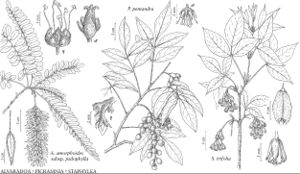Shrubs, rarely trees. Stems branched [single]. Leaves deciduous [persistent], cauline, opposite, usually ternate [odd-pinnate, 1-foliolate]; stipules caducous, extrapetiolar [intrapetiolar], distinct [connate]; petiole present; blade herbaceous, margins serrulate to serrate or crenulate-serrulate; leaflets: articulations or petiolule bases with 2 glands or stipels. Inflorescences terminal [axillary], thyrses, drooping. Flowers bisexual [unisexual, plants dioecious], perianth and androecium hypogynous; epicalyx bractlet absent; hypanthium short-campanulate; sepals 5, distinct or basally connate; petals 5, distinct; nectar disc lobed, surrounding bases of ovaries; stamens 5 in 1 series (alternating with nectary lobes), distinct, anthers X-shaped or sagittate, alternipetalous; pistils 1[–2], [2–]3(–4)-locular, carpels connate [distinct], ovary: placentation axile or axile-basal, styles (2–)3(–4), basally connate, distally postgenitally connate, stigmas expanded, flattened; ovules [1–]3–12 per locule. Fruits capsules [berries], inflated, usually 3-lobed, carpels becoming distinct distally, tardily so adaxially, and apically dehiscent; styles persistent, splitting. Seeds 1 or 2 per locule, not arillate [arillate].
Distribution
North America, Mexico, South America, Europe, Asia (to New Guinea).
Discussion
Genera 2, species ca. 45 (1 genus, 2 species in the flora).
A. Cronquist (1981) classified Staphyleaceae within Sapindales. His circumscription of the family included Tapiscioideae (Huertea Ruiz & Pavón and Tapiscia Oliver), now placed in Tapisciaceae (Huerteales), an order unrelated to Crossosomatales but close to Brassicales, Malvales, and Sapindales (V. Savolainen et al. 2000b; D. E. Soltis et al. 2000). Staphyleaceae are thus restricted here to the genera Dalrympelea Roxburgh (Turpinia Ventenat) and Staphylea (including Euscaphis Siebold & Zuccarini) (Staphyleoideae Arnott in Cronquist; generic delimitation fide S. L. Simmons 2007). Based on molecular phylogenetic data (V. Sosa and M. W. Chase 2003), the Angiosperm Phylogeny Group (2003) placed the Staphyleaceae in the strict sense within Crossosomatales, an order remote from Sapindales. Sosa and Chase, and Oh S. H. and D. Potter (2006), showed that Staphyleaceae are sister to Crossosomataceae, Guamatelaceae, and Stachyuraceae (Crossosomatales). Detailed morphologic information on the family was provided by W. C. Dickison (1986, 1987), M. L. Matthews and P. K. Endress
(2005), and Simmons (2007), among others. Matthews and Endress and Simmons indicated the presence of a floral cup in the family; the cup is here called hypanthium. The inflorescence is usually described as a panicle or raceme; it appears to be a thyrse. The fruit is usually interpreted as capsular; Matthews and Endress described it as follicular.
